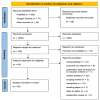Challenges, Barriers, and Facilitators in Telemedicine Implementation in India: A Scoping Review
- PMID: 39310647
- PMCID: PMC11414145
- DOI: 10.7759/cureus.67388
Challenges, Barriers, and Facilitators in Telemedicine Implementation in India: A Scoping Review
Abstract
Telemedicine has revolutionized healthcare access by breaking geographical barriers and facilitating remote consultations. The eSanjeevani platform has been pivotal in India, especially during the COVID-19 pandemic. Despite its benefits, implementing telemedicine faces various challenges and barriers. This scoping review aims to identify these challenges, barriers, and facilitators in the Indian context. This review follows the preferred reporting items for systematic reviews and meta-analyses extension for scoping reviews (PRISMA-ScR) guidelines. A comprehensive literature search was conducted using PubMed and Google Scholar to identify studies published between January 2019 and January 2024. Studies on telemedicine adoption, barriers, and facilitators in India were included. Data were extracted and synthesized from 26 quantitative, qualitative, and mixed-methods research studies. Individual-level challenges include limited digital literacy, particularly among older adults and those in rural areas, and health literacy issues. Barriers such as limited smartphone access, unreliable internet connectivity, and socio-cultural preferences for in-person consultations were identified. Facilitators at this level include family involvement, training programs, and community outreach. Provider-level challenges involve a lack of training and concerns about care quality, while barriers include insufficient infrastructure and medico-legal concerns. Facilitators include ongoing training, clear guidelines, and user-friendly telehealth systems. System-level challenges include integrating telemedicine into existing infrastructure and ensuring data security. Barriers include inadequate funding and resistance to change, while facilitators include policy support, investment in infrastructure, and collaborative efforts. Telemedicine holds great potential to enhance remote healthcare access in India, but its successful implementation requires addressing significant challenges and barriers. Strengthening digital infrastructure, enhancing digital literacy, standardizing protocols, and developing clear regulatory frameworks are essential. Collaborative efforts and tailored approaches that respect local cultures can further facilitate telemedicine adoption. Continuous research and public awareness campaigns are necessary to ensure telemedicine's sustainable and effective use in India.
Keywords: challenges & barriers; esanjeevani; facilitators; implementation; telemedicine.
Copyright © 2024, Arora et al.
Conflict of interest statement
Conflicts of interest: In compliance with the ICMJE uniform disclosure form, all authors declare the following: Payment/services info: All authors have declared that no financial support was received from any organization for the submitted work. Financial relationships: All authors have declared that they have no financial relationships at present or within the previous three years with any organizations that might have an interest in the submitted work. Other relationships: All authors have declared that there are no other relationships or activities that could appear to have influenced the submitted work.
Figures
References
-
- National telemedicine initiatives: essential to healthcare reform. Bashshur RL, Shannon GW, Krupinski EA, et al. Telemed J E Health. 2009;15:600–610. - PubMed
-
- Telemedicine - meaning, challenges and opportunities. Ittipong K, Watsawee S, Manachai T. Sir Med Jr. 2019;71:246–252.
-
- JanMitr: Telemedicine History in India. [ Jun; 2024 ]. 2024. https://www.janmitr.com/history.html. https://www.janmitr.com/history.html.
Publication types
LinkOut - more resources
Full Text Sources

